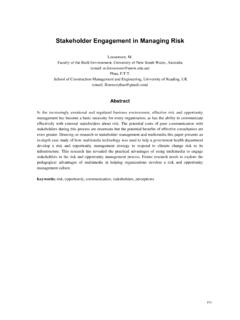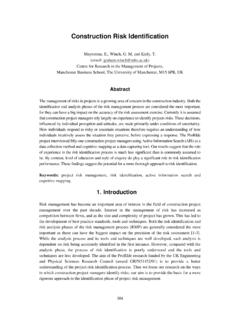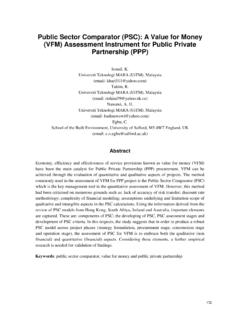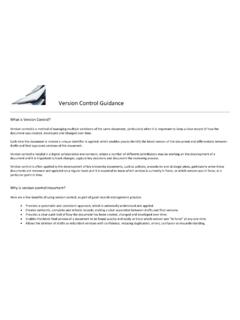Transcription of Factors Influencing the Project Cost - irbnet.de
1 CIB W55 & W65 Joint Triennial SymposiumCustomer Satisfaction : A focus for research & practiceCape Town : 5-10 September 1999 Editors: Bowen, P. & Hindle, Influencing THE Project COST ESTIMATING AKINTOYED epartment of Building and Surveying, glasgow caledonian University, glasgow , UKAbstractThis paper presents an empirical study of Factors Influencing cost estimating decisions ofconstruction contractors in the UK. While a large number of Factors influence the practice of costestimating, the ten most important are complexity of the Project , scale and scope of construction,market conditions, method of construction, site constraint, client financial position, buildability andlocation of the Project .
2 Analysis of variance, which tests the null hypothesis that the opinions of thevery small, small, medium and large companies are the same, was produced. This shows that, exceptfor the form of procurement factor, there is no difference of opinion, at 5% significance level, on thefactors Influencing cost : Cost estimate, tendering, cost estimators, Analysis of variance1 IntroductionCost estimating can be described as the technical process or function undertaken to assess andpredict the total cost of executing an item of work in a given time using all available projectinformation and resources [1]. The Code of Estimating Practice produced by the Chartered Instituteof Building [2] defines estimating as the technical process of predicting costs of construction andtendering as a separate and subsequent commercial function based upon the net cost estimate.
3 Green[3] compared estimating and tendering using systems concepts; estimating is classified as a closedsystem and tendering as an open system. According to Stewart and Stewart [4] underestimating a job may result in winning a competitivetender without allocating sufficient resources to perform the work, which may result in cost overrunor a loss of profit to the company. On the other hand, company that bids too high because ofinaccurate cost estimate may not be selected, due to their high bid, to execute the work. It isreckoned that both of these results have an adverse effect on the profitability of the [5] reckons that the process of cost estimating is very important as it enables constructioncompanies to determine what their direct costs will be, and to provide a 'bottom line' cost belowwhich it would not be economical for them to carry out the work.
4 Estimating practice tends to address such issues as: (1) who is going to do the work, (2) what thework content is (detailed specifications), (3) when the work is going to be done (scheduling), (4)where the work is going to be performed (on site, in factory - to be subsequently assembled on site)and (5) how the work is going to be performed. Nonetheless, an estimator is expected to considereither formally or informally Factors that are relevant to the successful execution of the Project . Thisis apart from other variable items such as production rates, material wastage and other historic costdata. This paper, therefore, presents Factors considered by construction contractors when estimating forconstruction work based on a survey of the UK contractors ranging from very small to large sizedfirms.
5 The need to identify these Factors becomes important, given that it has been argued thatdespite considerable literature on estimating practice, the primary focus is on estimating formats,procedures, and processes [6].CIB W55 & W65 Joint Triennial SymposiumCustomer Satisfaction : A focus for research & practiceCape Town : 5-10 September 1999 Editors: Bowen, P. & Hindle, A review of cost estimating factorsAzzaro et al's [7] empirical study commissioned by the Royal Institution of Chartered Surveyorsinvestigated cost estimating from the viewpoint of the quantity surveyor working in the contractingsector.
6 The study, based on a semi-structured survey of 11 main contractors and 2 sub-contractors,sought to identify current estimating techniques and the type of data bases used to arrive at tenderprices. Issues covered in the study included the determination of unit prices, preliminaries items, andallowances for profits and overhead, as well as the adjustment of prices to take account of suchfactors as market conditions, site conditions, location and the nature of the tender study failed to investigate the Factors considered by estimators as part of constructioncontractors' estimating practice.
7 Tah et al. [8], based on semi-structured interviews with seven contractors, investigated currentpractices of estimating the indirect costs (indirect costs were described as those which are nottraceable to a specific work item, and consist of site overheads, general overheads, profits andallowances for risks) involved in tendering for construction work. The study, whilst recognising thelimitation of the research due to low rates of response because of the sensitivity and confidentialnature of the subject, concluded by indicating a high degree of subjectivity involved in indirect costestimating.
8 It also recognised that the percentage added to the cost estimate is based on thesubjective judgement of senior management. The study reported that the subjective decision makingprocesses involved in these tasks are characterised by qualitative data and knowledge that is oftenvague and difficult to structure and quantify. However, no investigation was undertaken to identifyfactors that are considered by estimators in arriving at decisions on cost estimate. Skitmore and Wilcock [9] investigated estimating processes of smaller builders based on anexperiment conducted with eight practising builders' estimators.
9 The work investigated the processesof estimating rather than the practice of cost estimating, by looking at methods that estimators usedto price selected items from bills of quantities items and the variability associated with the motivation for this investigation was that little descriptive material is available concerning theprocesses employed by builders in determining a tender price. The research concluded that the mainfactor determining the rating method ( , method of preparing unit rates for bills of quantities items)was the item quantity, although this varied in importance between the work sections investigated(groundwork, in situ concrete and masonry).
10 An important conclusion emanating from the researchwas that not enough is known about Factors involved in cost estimating in decision, although there isa wealth of prescriptive literature available on the subject. The Code of Estimating Practice [2] prescribes that the estimator, in the course of preparing acost estimate, should carry out tasks such as a thorough examination of the tender documents, a sitevisit, preparation of method statements and the tender programme, visit to the Project consultants,make enquiries and receive quotations for materials, plant and sub-contractors. These tasks arerequired to determine an approach to pricing the Project at a level at which the costs of constructionresources could be recovered.

















